Bumbulummery: a Christmas tradition that you will probably not wish to revive
by Laura Wright
Reader in English Language, University of Cambridge
Lecture in memory of David Trotter (1957-2015) given at the University of Aberystwyth
I am honoured to be your speaker here tonight at this year’s David Trotter Memorial Lecture. My instructions were to talk to you on a subject I shared with David, so I’m going to show you one of the recent things we talked about.
I knew David from the time he was analysing the language of the records of Exeter Bridge and I was analysing the language of the records of London Bridge: the words, the grammar, and particularly the way of mixing of Medieval Latin, Anglo-Norman French and Middle English that we found there in accounts and inventories. Tonight I will begin by demonstrating what I mean by medieval mixed-language writing in order to set the scene, and I’ll then follow with specifics of what puzzled us lexically.
Medieval mixed-language business writing
Mixed-language writing was a trilingual mix of Medieval Latin, Anglo-Norman French and Middle English, written by scribes when keeping accounts and inventories. Before the Norman Conquest of 1066, Old English was the language of written record. But in 1066 the Anglo-Norman administration took over and Medieval Latin became the written norm, with Anglo-Norman French the spoken reality behind the first administrators who were the first scribes, and English the language of the people who lived in the new territory, plus Celtic languages in specific regions. So it’s not altogether surprising that a variety containing more than one language came into usage. Mixed-language writing had a regular structure: the outer grammatical skin was usually Medieval Latin (occasionally Anglo-Norman) but the roots of words, the nouns and verb-stems and adjectives were optionally English or Anglo-Norman – although they could be in Latin too. The rule was ‘don’t be monolingual’. Variety was key. Here’s a text from Domesday Book:
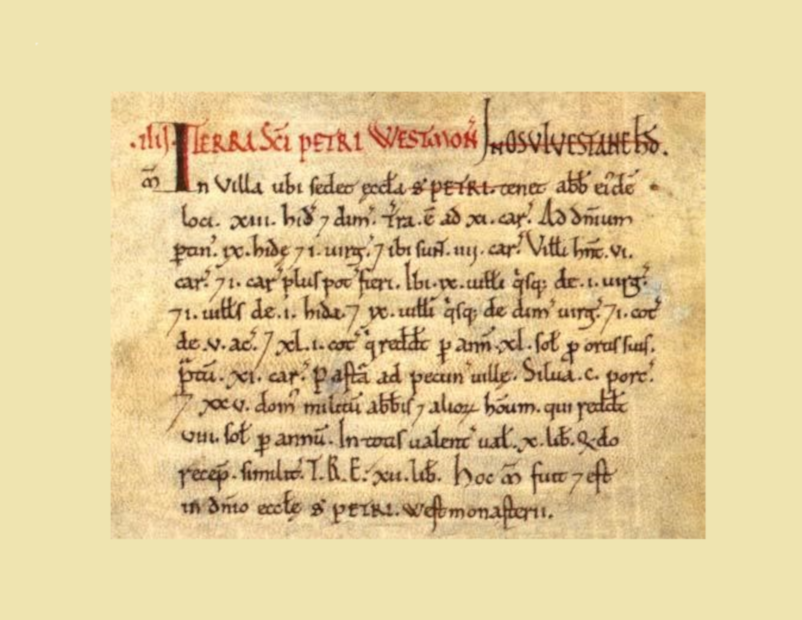
Domesday Book, post 1086. Latin with English and Anglo-Norman French.
Here is the text transcribed, with Latin in blue, Anglo-Norman in yellow, and English in red. I’ve greyed out ampersands and roman numerals, and blended the colours of words which belong to two languages (such as in and de). Words coined in spoken yellow Anglo-Norman borrowed into written blue Medieval Latin appear as green:
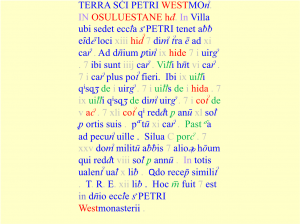
The main thing to note is that at this early date, the predominant language is Latin. English appears in names, like Oswald’s stone, and measurement terms, like hundred, hide and acre. Anglo-Norman appears in vilein ‘low-born man’, pasture ‘land for feeding on, maner ‘residence’, and there are some prepositions common to two languages – de [Latin + French]; in [Latin + English]. Like most medieval texts, Domesday Book uses the medieval abbreviation and suspension system of symbols which serve to obscure the Latin suffixes. I’m now skipping on a couple of hundred years, to a text written in 1279:
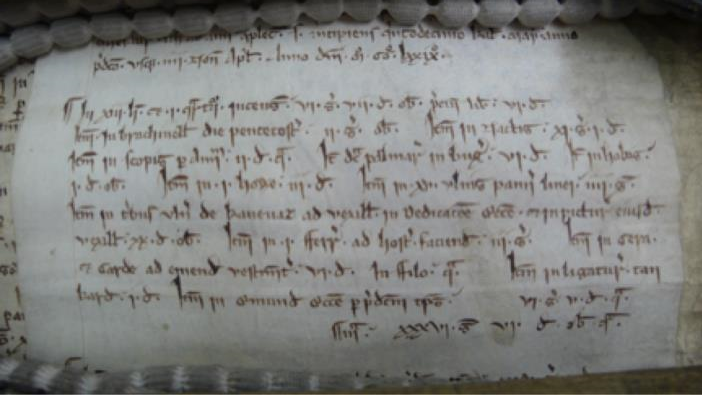
Extract from London Metropolitan Archives, MS 25171/1, Accounts of Expenses of Sacrist, St Paul’s Cathedral, 1279.
Here’s the text, colour-coded as before.
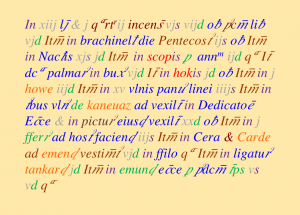
The main thing to note here is that by 1279, the matrix, the blue outer Latin skin, had reduced; and concomitantly the bi- or trilingual element had increased – words coloured brown, purple, green and orange – because by this date, they had been borrowed into the vocabularies of more than one language. Non-Latin words either have suspended suffixes (tankard), or have suffixes that belonged to more than one language (scoops, hooks), or have no suffix at all (canvas, hoe). I’m now skipping on to a text written in 1425:
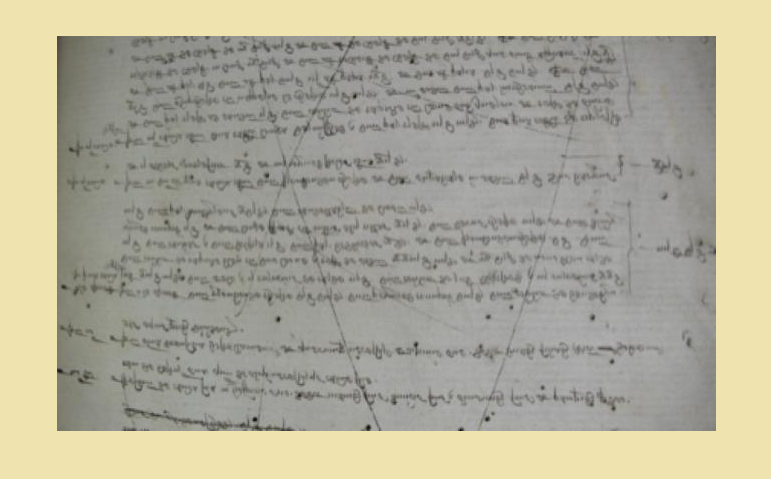
Extract from London Metropolitan Archives, MS 7086/1 (‘Audit Book 28’, Worshipful Company of Pewterers), Pewterer’s Company Master’s and Wardens’ Accounts, fol. 2, 1425
And here’s the colour-coded transcript.

By 1425, the outer Latin skin had become bare-boned. (Linguists will want to know why I’ve coded spitell ‘guesthouse’ yellow, when it is attested in Middle English at this date (answer: because it means ‘guesthouse’ here rather than ‘hospital’, and I haven’t found that sense in a monolingual English text); and will have similar questions about words for e.g. ‘felt’ and ‘cloth’ and ‘candelabra’: my technique here has been to find these words in monolingual Latin, French and English contexts and colour accordingly – but this is a position I will question below.) By this date, there is now a complete lack of word-final Latin grammatical suffixes on non-blue words.
This is a broad-brush view of developments over the 338 years covered by these documents. From 1087 through to 1425 – and indeed continuing on into the second half of the fifteenth century, the mixing rule was stable – it was put nouns and stems of verbs in English and French (variably, that’s to say, keep some Latin there too) but put all morphology – the small grammatical particles, the suffixes, the prepositions, the numbers – in Latin. The proportion of English and French to Latin grew over time, but the basic pattern of switching remained stable, until the Latin morphology gradually reduced too and then disappeared altogether as English came to predominate.
Any system in collective use changes over time and grammatical developments happened in this text type as might be expected, demonstrated here by the grammatical particle le. The Anglo-Norman definite article le became borrowed into Medieval Latin (Classical Latin didn’t have definite articles), and to start with, le was more or less limited to names and occupations:
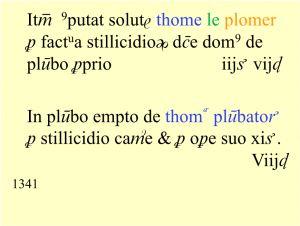
London Metropolitan Achives, CLC/313/L/D/001/MS25125/8, Dean & Chapter of St Paul’s Cathedral, London, Rental & Accounts
Thomas le Plomer was a plumber providing lead for mending gutters. His name is recorded in both Anglo-Norman and in Medieval Latin, but I’ve coded the le here as both French and Latin, because I want to draw attention to the fact that this small piece of grammar had become borrowed from French via speech into Medieval Latin. Charting its progression from names and occupations (which in the case of Thomas, were one and the same), le became used in the construction ‘price the x’, where x is a commodity, be it goods, material, a time-span, or anything else that required paying for. Here is another entry from the accounts of St Paul’s Cathedral:
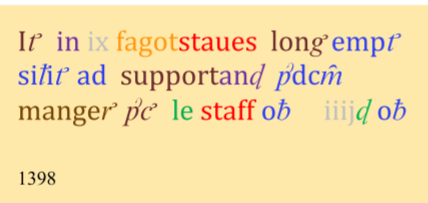
By 1398, le could premodify staff, which unlike plomer is of English etymology (the preceding word, precium or price, could be all three: for more examples of this sort see Trotter (2010) or Wright (2017)). Here’s some entries with and without le, this time in prepositional phrases taken from the archive of London Bridge in accounts for the years 1426-1431:
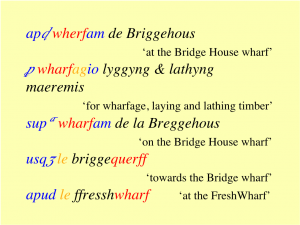
The first three extracts here show the Latin prepositional phrase in action: a Latin preposition governs a Latin case-ending which sits at the end of a noun, which in this case, is the English word ‘wharf’ (different prepositions governed different endings: apud and supra take –am, pro takes –io). The second extract shows an extra segment in the middle, wharfagio. This is the Anglo-Norman suffix –age, which sat at the end of nouns to indicate a tax: murage was a tax for tying up at a wall, pontage was a tax for going under a bridge, and wharfage was a tax for unloading goods at a wharf, giving a trilingual word made up of English root wharf, Anglo-Norman suffix –age ‘tax’, and Latin case-ending –io matching up with preceding preposition pro. (In this illustration, I’ve coded –ag– and le yellow in order to stress their French origin, but this text shows they had become borrowed into Medieval Latin.) This is the earlier way of writing prepositional phrases in mixed-language texts. However a new way developed using the particle le, shown in the last two examples. Here, the prepositions usque and apud are followed by le, which is then followed by a nonLatin noun without a case-ending.
The new prepositional phrase rule was that definite article le always precedes a nonLatin noun and always blocks a Latin suffix on that noun – even though non-Latin nouns had been taking Latin suffixes for decades in mixed-language writing. (I should also mention the development of the morpheme –ing entering into the Noun Phrase from the late 1300s onwards: lyggyng & lathyng is a development of the late fourteenth century. Notice also the ‘Scottish’ <qu> spelling for <wh> – in quotes because it occurs in London writing in low-frequency ratios.)
Here’s both systems in use in the same text from the archive of London Bridge: pro custodiendum gigantum, and pro les geauntes:

The article le signalled a switch out of Latin, a deduction based not only on the etymology of the noun, but also on its lack of Latin morphology. Le and la did not mark grammatical gender in mixed-language texts in the fifteenth century, but continued on with this new function, that of marking non-Latin.
David was particularly interested in that le, and how it undercut the whole concept of what should and shouldn’t be included in the Anglo-Norman Dictionary. It is policy that non-French-looking nouns preceded by le like le staff or le wharf be included, on the basis that le is French so the following noun must be French too. But David came to realise that in mixed-language writing produced in Britain, le preceded something that wasn’t Latin – not something that was necessarily French. Are the giants here French alone, or English as well? Based on le alone, they could be either. The <aun> sequence of letter-graphs is distinctively Anglo-Norman, but the sequence was also borrowed into Middle English writing, so these giants can also be regarded as English, and indeed the spelling geauntes can be found in the Middle English Dictionary – although it’s included there because it occurs in a monolingual English context, not because of this mixed-language token. Mixed-language evidence poses real problems for the dictionaries; supposing this were the only attestation of geauntes extant? Would it be evidence that geauntes was an English word at this date?
David questioned should we go even further and say the le signals that the giants are English/French and that the two languages were not distinguishable? In the end he rejected this conclusion, deciding that scribes were well aware which language was which. In his superb 2014 article “Where Does Anglo Norman Begin and End?” he wrote:
The essential point is that our assumptions about the boundaries between languages are difficult to perceive at this distance, but that it is not obviously the case that matters then were as we would interpret them now.
…
In the case of personal names, the boundaries are more muddled still …. In part, this is because first attestations of proper names … are often in documents such as witness-lists, where there is no discernible referent ….
This, obviously, makes it almost impossible to determine which language we are dealing with unless the (unabbreviated) suffix clarifies this. So, for example, in the following case, it is reasonably certain that Roland …is being designated by an Anglo-Norman name, since the spellings all end in –ur or
–our …:
(and then he gives a definition of a word which he had just drafted; distinguishing French pet(o)ur from English petter):
[petour], pettour, pettur
- one who (frequently?) breaks wind, (habitual?) farter (used as a surname): serjantia que quondam fuit Rollandi le Pettour . . . pro qua debuit facere die Natali Domini singulis annis coram domino rege saltum et sifflettum et unum bumbulum DMLBS sub bombulus; dicunt quod Rollandus le Pettus (l. Pettur) tenuit . . . serjantiam faciendi saltum, siffletum, pettum DMLBS sub siffletum.
… He provides … what is thus far the only evidence for the clearly AngloNorman substantive petour, and indeed the only instances in French lexicography outside—and earlier than— Latin-French glosses of the fourteenth century (cf. Gdf 10:328c; Tobler, Lommatzsch, and Christmann 1925-2002:7,867; DMF sub péteur; FEW 8:132a: “14.-15jh.”). (Trotter 2013: 148-9)
David’s argument here is that although Roland has a surname in a Latin context, petour must have been an Anglo-Norman word, not just because of etymology and preceding le, but also because of the Anglo-Norman graphies –our in the suffix.
David had just drafted this entry because I had sent Roland over to him:
bombulus rumbling, breaking wind (cf. bombus c). 1250 serjantia que quondam fuit Rollandi le Pettour ‥ pro qua debuit facere die Natali Domini singulis annis coram domino rege saltum et sifflettum et unum bumbulum Fees 1173.
Dictionary of Medieval Latin from British Sources
I’d found Roland in the Dictionary of Medieval Latin from British Sources, and I’d looked up petour in the Anglo-Norman Dictionary to no avail. David immediately rectified that, and he sent me his draft entry under the subject-line ‘bumbulummery’ – his own, made-up word for the thing in question. My question tonight is: what language is the thing in question, and how can we tell? The Dictionary of Medieval Latin from British Sources contains as much English and Anglo-Norman as it does Latin, because it includes words from mixed-language sources.
This quotation comes from a book called Liber Feodorum, or the Book of Fees, compiled in 1302. It is a list of feudal landholdings, and it refers to a serjeanty. A serjeanty was a landholding for which the holder had to perform some kind of service to the king in lieu of rent. Other people had to give bows and arrows, palfreys, goshawks, things for making tents. The Book of Fees tells us that in Hemingeston in Suffolk, Roland le Pettour had to perform the service of bumbulum to the king on Christmas Day in order to have the right to hold his land. This is what the entry in the manuscript Book of Fees looks like:
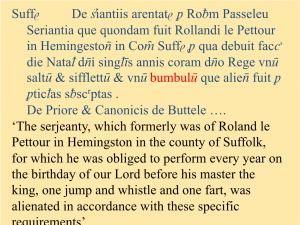
The National Archives, E 164/6, Book of Fees (Liber Feodorum, Testa de Nevill), volume 2, p. 310
(I have copied this translation; but I suggest that actually it refers to two kinds of fart: a ‘little hiss’ and a ‘little boom’.)
Roland had to perform bumbulum at Christmas, at Royal Command. Of course we still have Royal Command Performances at Christmas, they tend to take place at the London Palladium nowadays. Is it pure coincidence that the serjeanty immediately below Roland’s is that of the Prior and Canons of Buttele? (They just had to pay 25 shillings for the right to hold their land, no speciality tricks for them.)
The word salt is in the Anglo-Norman Dictionary, a jump, a leap. But sifflet, a little sifle, a hiss, is not, nor is bumbule, a little boom, and this is because these words have not been found in a monolingual Anglo-Norman context. The Dictionary of Medieval Latin from British Sources does contain siflet, and has no hesitancy in ascribing it to French, although it has no other evidence than the Book of Fees:
siffletum, siffletum [OF sifflet] (act of) whistling, whistle. 1219 W. le E. tenet
‥ quandam sergantiam per unum siflet et unum saltum et cetera (Norf) Fees 279; c1227 dicunt quod Rollandus le Pettus tenuit ‥ serjantiam faciendi saltum, ~um, pettum (Norf) ib. 386; 1244 E. de B. tenet Hemelingeston’ ‥ et est ista serjantia faciendi unum saltum, ~um, et pettum (Suff) ib. 1151; 1250 serjantia que quondam fuit Rollandi le Pettour in Hemingeston’ ‥ pro qua debuit facere die Natali Domini ‥ coram domino rege unum saltum et sifflettum et unum bumbulum (Suff) ib. 1174. Dictionary of Medieval Latin from British Sources
The Book of Fees is a repository of contracts made over the previous century; Roland’s here dates from 1250. There is an earlier Suffolk serjeanty in the Book of Fees, copied from a roll dated 1235:

The National Archives, E164/6, volume 2, p. 355
Sibile is not in the Anglo-Norman Dictionary as a noun, although it does occur in a monolingual Anglo-Norman context as a verb so it does have a headword. Notice how the scribe of the original roll had written the nasal before the stopped consonant as an <n> graph in Brunton (Brumton, Brompton) as well as Bunbi (bumb, bomb) and the scribe of 1302 has presumably kept what he saw. (I’m assuming the suffix –i is Latin genitive singular, like puer ~ pueri, a masculine 2nd declension noun). What’s interesting here is the earlier form has the root alone plus a genitive singular suffix, something like and ‘for the service of a jump, a hiss and a boom’; and the later entry of 1250 has the diminitive suffix, the siflet, a little hiss, and unum bumbulum, ‘a little boom’. I said that the Book of Fees copied these serjeanties from earlier rolls: some are extant and I managed to track one of them, but here we find the other root, as in Roland’s name, for the thing in question. Here is the relevant extract, from a roll dated 1226:
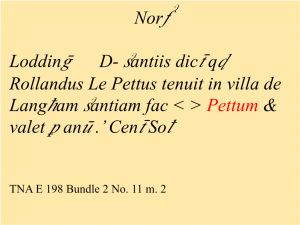
The National Archives, E198, Bundle 2 No. 11 m.2
The letter-graphs indicated by angled brackets are now too faint to be seen, but the spelling for the thing in question is clearly Pettum. Turning to the Middle English Dictionary we also hear of Baldwin le Pettour holding the same serjeanty in Hemmingston in Suffolk some time before 1205, so Roland wasn’t breaking ground, and of Walterus Fartere in 1234, and of Johannes le Fartere, who was from Aylleston (Aylestone) in Leicestershire, in 1327 (MED sub ferter(e)). By the anterior logic of the preceding le marking French, John’s name ought to warrant a mention in the Anglo-Norman Dictionary under the same headword as MED’s, but he does not as yet have one.
David’s question was, how can we know what language petour is, and he argued as we’ve seen that the distinctive suffix made it legitimately Anglo-Norman, notwithstanding it may also have been Medieval Latin and English. My question is: what language is the root of bunbi and bumbulum, the boom and the little boom?
Turning to the Dictionary of Medieval Latin from British Sources under bombus, subdivision c.:
bombus, bombum, bomba [βόμβος] bellow. b peal. c rumbling, breaking wind. aurea hunc bombis nascentem bucula vatem | signavit ALDH. VirgV 285. b clamat barbita bombis ALDH. VirgV 2789; omnia signa sonant feriunt atque aethera bombis WULF. Swith. I 1027. c 1235 per servicium saltus, sibile et bunbi Fees 404; c1370 (v. bombinare); a farte, bumbum, bumba, pedicio, trulla CathA. Dictionary of Medieval Latin from British Sources
The first quotation under c. is a variant from the same document we’ve already seen. The second is from the Catholicon Anglicum, an English–Latin wordbook, an early dictionary, of some time before 1483, published as a Camden Society volume (Camd. Soc. NS XXX, 1882). It’s good to find another source, so now we have the bomb– root for the thing in question in two serjeanties and a wordlist.
Although Roland le Pettour’s bumbulum looks Latin, we know that English and Anglo-Norman words routinely took Latin endings. So let’s investigate the semantic field. The most high-frequency Latin word for the item in question came from the Latin root ped-, giving the Classical Latin verb pedere, past participle peditus, used as a noun, and also the noun peditium, leading to the noun pet, as evidenced in Tony Hunt’s Teaching and Learning Latin Thirteenth-Century England vol 2. (Cambridge, 1991), and to Roland and Baldwin’s surnames. Anglo-Norman too seems to have mainly used the ped– root; here’s the current entries from the Anglo-Norman Dictionary:
[petour]1, pettour, pettur
[FEW: peditum; Gdf: ; GdfC: 10,328c peteur; TL: 7,867 petor; DEAF: pet (petor); DMF: péteur; TLF: péter (péteur); OED: ; MED: ; DMLBS: 2166b pedo 2]
s.
one who is in the habit of breaking wind, farter (used as a surname):
1219 serjantia que quondam fuit Rollandi le Pettour […] pro qua debuit facere die Natali Domini singulis annis coram domino rege saltum et sifflettum et unum bumbulum DMLBS sub bombulus (206a);
1250 dicunt quod Rollandus le Pettus (l. Pettur) tenuit […] serjantiam faciendi saltum, siffletum, pettum DMLBS sub siffletum (3073a)
peire1, pere, poire
[FEW: pedere; Gdf: 6,256c poire 2; GdfC: ; TL: 7,1332 poirre; DEAF: poirre; DMF: poirre; TLF: ; OED: ; MED: ; DMLBS: 2164b pedere] .
v.n.
to break wind, fart:
(ms. s.xii4/4) Viel estalon fait jone poutre peire Prov vil 13.352;
(s.xiii2 ms. s.xiv2/4) Plus gaigne l’un par peire, ke l’autre par esternuer Respit 155.13;
v.refl.
to break wind, fart:
(ms. 1271-83) A la fenestre se poia, Son seignur par iloec gweita. E quant le prodom entendi Coment sa feme li out servi, Pria lui que le us defermast Fabliaux 14.111
[peter]1, peiter
[FEW: peditum; Gdf: ; GdfC: ; TL: ; DEAF: pet (peter); DMF: péter 1; TLF: péter; OED: ; MED: ; DMLBS: 2164b pedere]
v.n.
to break wind, fart:
1216-25 (ms.1307-15) un de la vile estut sur le mur e mustra sé genitals a ceus dehors, e peita en despit des Normanz Reis Engl 144
pet1
[FEW: peditum; Gdf: ; GdfC: 10,328b pet; TL: 7,848 pet; DEAF: pet; DMF: pet; TLF: pet; OED: pet n.1; MED: ; DMLBS: 2166a peditium] s.
fart, act of breaking a wind:
hoc peditium: pet, anglice fart TLL ii 107;
(ms. s.xii4/4) Tart est main a cul quant pet est hors Prov vil 6.85
Geert de Wilde has spent much time carefully cross-referencing these entries for us so that we can see that that Latin root was as in Roland’s surname. OED provides the anterior history:
OED Pet, n.1
Middle French pet (c1179 in Old French; French pet) < classical Latin pēditum, use as noun of neuter of pēditus, past participle of pēdere to break wind ( < the same Indo-European base as Lithuanian bezdū, ancient Greek βδεῖν, apparently ultimately an imitative formation representing the sound of breaking wind). Compare post-classical Latin pettum (c1227, 1331 in British sources), Old Occitan, Occitan pet, Catalan pet (14th cent.), Spanish pedo (c1400), Italian peto (13th cent.).
But there were also other words for the thing in question in Classical Latin, namely:
crepitus [CL], crepita noise. b snapping of fingers. c fart. sum cava bellantum crepitu quae corda ciebo ALDH. Aen. 68 (Salpix) 1; 9‥ ~us, i. sonitus, fragor, sonus ‥, cyrm, flamen, sweg GlH C 2055; 9‥ ~um, þununge WW; fera ‥ | terribilis rictu, crepitu R. CANT. Malch. V 122; audivit atque infra se persensit quasi lignei roboris contriti ~us asperrimos crepere R. COLD. Cuthb. 120; sensit ~um in extensione nervorum et ita plene reddita est sanitati Canon. G. Sempr. 142v. b pollice cum digito crepitas formare caveto D. BEC. 1210. c portitor obiter fossam transiliendo fissa nate ~um dedit GIR.
IK I 11.
Dictionary of Medieval Latin from British Sources
The root is crepita-, giving the verb crepitare, meaning to ‘rattle, crackle or similar’, as the Dictionary of Medieval Latin from British Sources puts it. OED has it under headword crepitate:
OED crepitate, v. 1. ‘to break wind’: “< Latin crepitāt–, participial stem of crepitāre to crackle, frequentative of crepāre to crack, creak”.
And there was also the root of the medical term flatus, flatulence: Medieval Latin flatuosus, from Classical Latin flare, ‘to blow’.
So there were several good Latin words all doing the job, the peditum/peditius group; the crepitus/crepita group, and the flatuosus group. Of course there’s always room for more. It is completely reasonable under the circumstances that the bomb- group be coined from Latin bombus < Greek βόμβος ‘boom’; after all, the thing in question does range from the whistling or hissing end, the sifflettum, to the booming end, the bumbulum.
I have looked in vain for bumbule and bombe in a monolingual Anglo-Norman context. But how about English? There is a candidate: bumble, as in ‘bumbling fool’, which you will now use more thoughtfully, now that you have learnt about Roland and Baldwin and their expertise.
So, we now need to look at the earliest attestations in English of bumble. Here’s some relevant entries, with earliest attestations in the late 1300s:
OED bumble, v.1
Etymology: Ultimately < an element imitative of a buzzing, humming, or droning sound (compare boom v.1, bum v.2) + –le suffix.
- intransitive.
†a. Of a bittern: to make its characteristic call; to boom (see boom v.1 1a). c1405 (▸c1395) Chaucer Wife of Bath’s Tale (Hengwrt) (2003) l. 945 As a Bitore bombleth in the Myre [c1415 Corpus Oxf. bumliþ, c1430 Cambr.
Gg.4.27 bumbith].
- Of a bee, fly, etc.: to buzz; to hum. Also in extended use: to make a sound like a bee buzzing.
1689 R. Hogarth Gazophylacium Anglicanum at To rebound To bumble, or humble like Bees.
OED bumbling, n.1
Origin: Formed within English, by derivation. Buzzing, humming; (especially) the buzzing of a bee.
c1450 (▸c1405) Mum & Sothsegger (BL Add. 41666) (1936) l. 1028 (MED) The bomelyng of þe bees..Thair noyse and þaire notz at eue and eeke at morowe.
OED bumblebee, n.
1530 J. Palsgrave Lesclarcissement 460/1 I bomme, as a bombyll bee dothe.
OED bumble, n.1 Etymology: < bumble v.1
- A bumblebee (genus Bombus).
1599 ‘T. Cutwode’ Caltha Poetarum cxxxvi The Bumble nods his head, & makes an offer.
So in texts of around 1400, we find verb bombleth and noun bomelyng meaning the noise produced by bitterns and bees – in particular, I note The Wife of Bath, that earthy text of bodily functions. Let’s look at the earliest uses of boom:
OED boom v.1
Of imitative origin; whether original in English it is impossible to determine; compare German bummen , Dutch bommen , of similar meaning, Old Dutch bom a drum; also bomb n., which in its origin is closely allied.
c1440 Promptorium Parvulorum 55 Bombon as been [K., H., 1499 bummyn or bumbyn], bombizo.
Notice how bombon as been doesn’t work with present-day meanings of ‘boom’; bees don’t boom in the modern sense of boom, although they could indeed be said to boom in the sense of Roland and Baldwin’s specialism. Boom can be spelt in various ways:
OED bum, v.2
- †a. intransitive. Of a bittern: to make its characteristic booming call; to boom (see boom v.1 1a). Obsolete. c1430 (▸c1395) Chaucer Wife of Bath’s Tale (Cambr. Gg.4.27) (1872) l. 972 As a bitore bumbith [c1405 Hengwrt bombleth] in þe myre.
Here is a bittern’s boom:
Notice the similarity to that wind instrument which gives us another word for the thing in question, the trump, from Anglo-Norman, which interestingly has a sense meaning ‘to make a fool of’, given in the Anglo-Norman Dictionary under trumper sense 3. In English, as well as meaning the thing in question, a trump meant a trick. But staying with the bittern for a moment, its etymology is not at all clear. OED bittern, n. says it is from Middle English botor, from Old French butor, of obscure origin, with English forms in bit- probably representing French ü. The final -n is due to mistaken analogy with alder, aldern, elder, eldern, etc. Dialectally in Northern and Midland counties the bittern is known as a butterbump (English Dialect Dictionary), a butt-a-bum. I spoke earlier of the Prior and Canons of Buttele in Suffolk: the etymology of the word butt is also not clear. The poet Tennyson, who was from Lincolnshire, has his old farmer say “Ah heer’d the butter-bumps boomin’”, presumably something like [bʊtɘbʊmps bʊmɪn] and under butt n.6, OED says “Origin uncertain. A derivative of this word is apparently shown by buttock n., in which case currency at least as early as the beginning of the 14th cent. is implied.” After a list of cognates in Germanic languages, the following Anglo-Norman etymology is pondered:
However, it is unclear whether the word shows a cognate of these Germanic forms (not recorded in Old English), or a borrowing from either early Scandinavian or from another West Germanic language. It is also possible that it could show a borrowing from Anglo-Norman and Old French, Middle
French bout end (see butt n.5), although that is made less likely by the fact that that word is not recorded in the specific sense ‘thick end’.
The French word bout meant the end of something, and I think that’s exactly what we’ve got with both the booming bittern and the booming Roland and his colleagues.
Which brings us to bum, n.1, of which the OED says there is no certain origin, but which is also first known of from the late 1300s:
OED bum, n.1 and int.2
Origin: Of uncertain origin. Perhaps an imitative or expressive formation.
- n.1 1.a. A person’s buttocks; the bottom, the backside.
▸ a1387 J. Trevisa tr. R. Higden Polychron. (St. John’s Cambr.) (1876) VI.
357 It semeþ þat his bom is oute þat haþ þat evel
(Whilst I agree that bum is both imitative and expressive, I fail to see how, without prior knowledge of Roland and Baldwin’s skills, readers are meant to interpret this explanation.)
Bum is unlikely to be a contraction of bottom because bottom isn’t found in this sense until the middle of the sixteenth century (OED bottom, n. and adj. A. I. 8). If bunbi and bumbulum are evidence of an English verb bumble meaning ‘to break wind downward’, then the bum is the part of the body that emits said boom:
OED break, v. Phrases P.6
1552 R. Huloet Abcedarium Anglico Latinum Belke, or bolke, or breake wynde vpwarde.
1606 P. Holland tr. Suetonius Hist. Twelve Caesars 171 He would give folke leave to breake winde downward and let it goe even with a crack at the very bourd.
It is no coincidence that OED’s bumble, n.3 has two dialectal attestations of bulrushes known as “Bumbles, such as are used for chair-bottoms”, as in “The chair’s got a bumble bottom” and “I can’t abide them bumble-seäted chairs” (Lincolnshire). Indeed the bul– of bulrush is of uncertain origin; a compression of bumble-rush [bʊmlrʊʃ] > [bʊlrʊʃ] is entirely possible, requiring only consonant simplification (omission of nasalisation and the epenthetic homorganic stop at the syllable boundary). In Northumberland, Durham, Cumberland, Westmoreland and Yorkshire blackberry fruit is or was known as bumble-kite: “The fruit is vulgarly known by the name of bumblekyte, from its being supposed to cause flatulency when eaten in too great a quantity” (English Dialect Dictionary).
Here’s the Middle English Dictionary on bomben, we’ve already seen meanings a) and b), here’s c):
MED bǒmben (v.) [Imitative.](a) Of the bittern: to boom; (b) of a bee: to buzz; (c) of a person: to drink with a gurgling sound, guzzle.
(c) c1390 PPl.A(1) (Vrn) 5.137: Peni Ale and piriwhit heo pourede togedere..Hose Bummede þerof, Bouȝte hit þer-after. c1390 PPl.A(1) (Vrn)
7.139: Ones at Noon Is I-nouȝ..He abydeþ wel þe bet þat Bommeþ not to ofte.
This is the famous medieval poem Piers Plowman, and I don’t think that drinking is implicated, nor do I think that gurgling is the right kind of rumbling. OED has given it a completely separate entry, which is surely excessive, because bom/bum has no ‘drink’ meanings:
OED bum, v.1
Origin: Probably an imitative or expressive formation.
Etymology: Probably imitative of the motion of the lips in drinking.
intransitive. To drink, (probably) esp. in a greedy or guzzling manner.
c1390 (▸a1376) Langland Piers Plowman (Vernon) (1867) A. vii. l. 139 He abydeþ wel þe bet þat Bommeþ not to ofte.
Let’s look at this use in Piers Plowman (c1390):
Penyale & pilewhey heo pouride togidere / For laboureris & louh folk þat lay be hmselue / þe beste in my bedchaumbre lay be þe wouh / And whoso bummide þerof bouhte it þereaftir (A (1) 5.137)
Ones at Noon Is ynouh þat no werk vseþ / He abideþ wel þe betere þat bummiþ nouht to ofte (A (1) 7.139)
Most translations of Piers Plowman translate bummide and bummiþ as ‘drink’ or ‘taste’, and although two MSS have our verb, other manuscript versions do have bibbith and etyth at this point. But bomben doesn’t mean ‘to drink’ in any other context, whereas ‘break wind downwards’ is attested by Roland and his colleagues.
In sum: a reading of ‘break wind downwards’ for all these bomb- words hinges on treating what looks like Medieval Latin not as Latin but as Anglo-Norman and English. Not only was David concerned to unsettle which words did or did not belong to Anglo-Norman, he was also particularly concerned in several of his most recent articles to show how Anglo-Norman was used in far wider senses than the courtly register it has been depicted as, and he had searched through the English Dialect Dictionary pulling out all the dialect etymology, and was gathering a collection of Anglo-Norman field names as illustration. Tonight’s bomb- words help to make his point.
As a tailpiece, I should mention that David and I were not the first to take interest in Baldwin and Roland’s surname. William Camden (1551-1623), historian and herald, wrote in his Remaines of a Greater Worke, Concerning Britaine of 1605 (i.117):
Baldwin le-Pettour..held his land in Suffolke, Per saltum, sufflum & pettum, sive bumbulum, for dauncing, pout-puffing, and dooing that before the King of England in Christmasse holy dayes, which the worde Pet signifieth in French.
Pout-puffing, that’s a new one to add to our collection.
In 1679, Thomas Blount, lexicographer, wrote a book called Fragmenta Antiquitatis, antient Tenures of Land, and Jocular Customs of Some Manors; and in it he mentions Roland and his annual Christmas obligation “that he should dance, puff up his cheeks, making therewith a sound, and let a crack”. In 1739 the antiquarian Francis Blomefield included mention of Baldwin in his Essay towards a Topographical History of the County of Norfolk, telling us that Baldwin was “obliged by his tenure to come into Westminster-Hall, or where-ever the King was, and there to take a leap, cry hem, and let a fart, (per saltum, sufflatum et pettum) before the King on Christmas yearly”. In 1827 The Gentleman’s Magazine mentions Roland and Baldwin and their Christmas obligation, but tells us that “This was afterwards considered an indecent service, and was rented at sixteen shillings and eight pence the year”. So Roland and his colleagues were reported on in the 1600s, the 1700s, the 1800s, the early 1900s when the Book of Fees was transcribed and printed, and the late 1900s when the entry under bombulus was composed for the Dictionary of Medieval Latin from British Sources. Every generation has been keen to keep Roland and Baldwin’s memory alive, and tonight we have done our bit to perpetuate this ancient Christmas tradition.
***
Bwm Bwm
My gratitude to several members of the audience, Andrew Evans, and my colleague David Willis, who contributed the following information on Celtic birds and bees:
- Bitterns boom in Welsh as well as Middle English: Deryn y bwn is a traditional Welsh folk song about a bittern who goes bwm bwm bwm bwm as he travels across the Beacons, where <w> represents [ʊ].
- Bees boom in Latin and Welsh as well as Middle English: Welsh cachgi bwm ‘coward-boom’, Latin Bombus terrestris ‘earth-boom’, Bombus lucorum l. ‘groveboom’, Bombus lapidarius ‘stone-boom’, Bombus pascuorum ‘pasture-boom’, B. hortorum ‘garden-boom’, B. vestalis ‘Vestal-boom’ (http://treborth.bangor.ac.uk/bumble–bees.php.cy). Wikipedia sub Bombus says the Latin genus name bombus was assigned by Pierre André Latreille in 1802, derived from the Latin word for a buzzing or humming sound. Welsh dung-beetles too: chwyrli bwm ‘whirly-boom’. Geiriadur Prifysgol Cymru/A Dictionary of the Welsh Language (http://welsh–dictionary.ac.uk/gpc/gpc.html) attests bwm(p) in an undated addition to a 14th-century manuscript Goddic ywyrbwmp mawr drwmp moch gweuyl, which looks like it might mean ‘Fierce is the great boom of the trump(et) of a pig’s lips’ – the context is now unreadable.
- John Derrick’s The Image of Irelande of 1581 shows a woodcut of two braigetoírs (Baldwin and Roland’s opposite numbers in Ireland) in operation. Greer Ramsey (2002. “A Breath of Fresh Air: Rectal Music in Gaelic Ireland”, Archaeology Ireland 16, 1, 22-23) explains that the lower braigetoír is preparing to perform by bending over horizontally to draw in air, and the upper braigetoír is providing entertainment by expelling it out again in controlled fashion.
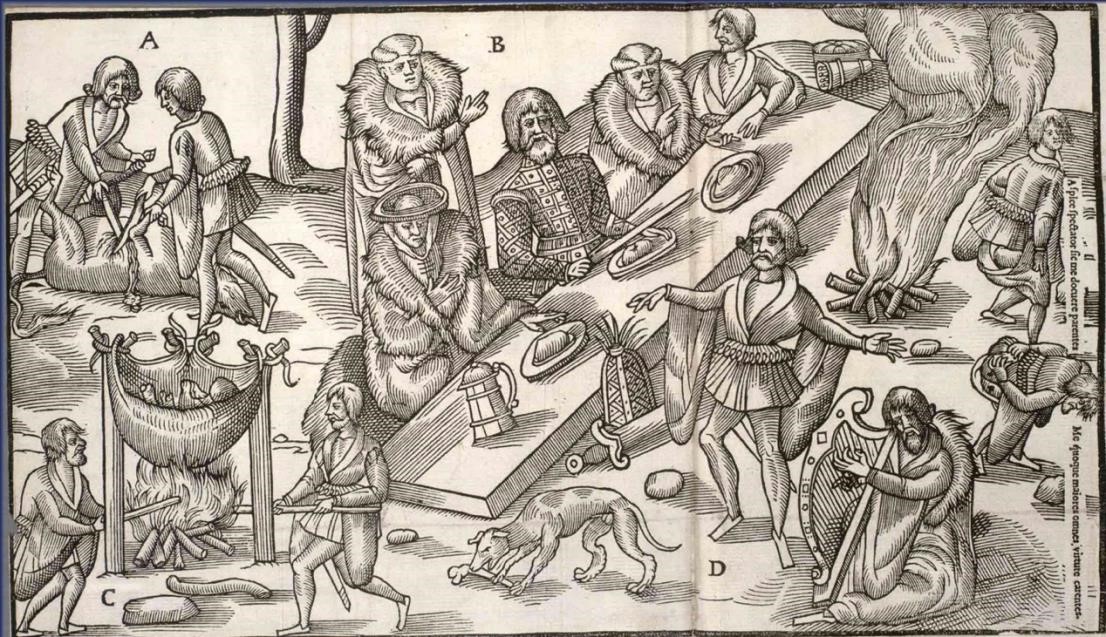
From: “The Image of Irelande, with a discouerie of VVoodkarne”, Edinburgh University Library Research Collection
Selected References
Anglo-Norman Dictionary: www.anglo-norman.net
Dictionary of Medieval Latin from British Sources: www.dmlbs.ox.ac.uk
English Dialect Dictionary: http://eddonline-proj.uibk.ac.at/
Middle English Dictionary: https://quod.lib.umich.edu/m/med/
Oxford English Dictionary: www.oed.com (bumbulum is under pout, n.2)
Liber Feodorum. The Book of Fees, Commonly Called Testa de Nevill: Part 2, A.D. 1242-1293. Pref. H.C.M. Lyte. London: His Majesty’s Stationery Office, 1923.
Trotter, David Andrew. 2010. “Bridging the Gap: The (Socio)linguistic Evidence of
Some Medieval English Bridge Accounts”. In Richard Ingham, ed. The Anglo-
Norman Language and its Contexts. Woodbridge: Boydell and Brewer. 52-62.
Trotter, David Andrew. 2014. “Deinz Certeins Boundes: Where Does Anglo Norman Begin and End?” Romance Philology 67 (1), 139-175.
Wright, Laura. 2017. “On non-integrated vocabulary in the mixed-language Accounts of St Paul’s Cathedral, 1315-1405”. In Richard Ashdowne and Carolinne White, eds. Latin in Medieval Britain. Proceedings of the British Academy 206, London: British Academy. 272-298.
